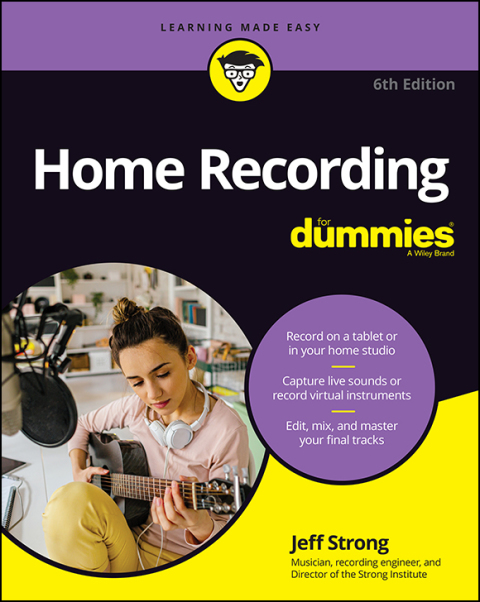Description
Efnisyfirlit
- Cover
- Title Page
- Copyright Page
- Introduction
- About This Book
- Foolish Assumptions
- Icons Used in This Book
- Beyond the Book
- Where to Go from Here
- Part 1: Getting Started with Home Recording
- Chapter 1: Understanding Home Recording
- Examining the Anatomy of a Home Studio
- Getting a Glimpse into the Recording Process
- Making Sense of Mixing
- Adding the Final Touches
- Chapter 2: Getting the Right Gear
- Determining Your Home Studio Needs
- Detailing Your Digital Options
- Computer-Based Digital Recording Systems
- Studio-in-a-Box Systems
- Mobile-Device Recording
- Exploring Sample Setups
- Chapter 3: Getting Connected: Setting Up Your Studio
- Understanding Analog Connections
- Delving into Digital Connections
- Working Efficiently
- Optimizing Your Room
- Chapter 4: Meet the Mixer
- Meeting the Many Mixers
- Understanding Mixer Basics
- Chapter 5: Multitrack Recording
- Understanding Multitracking
- Getting Ready to Record
- Setting a Tempo Map
- Saving Your Work
- Sharing Files with Others
- Part 2: Working with Microphones
- Chapter 6: Understanding Microphones
- Meeting the Many Microphone Types
- Assessing Your Microphone Needs
- Deciding How Many Microphones and What Kind
- Finding the Right Mic for the Situation
- Partnering Mics with Preamps
- Considering Compressors
- Analyzing Some Microphone Accessories
- Caring for Your Microphones
- Chapter 7: Taking a Look at Microphone Techniques
- Singling Out Close Miking
- Detailing Distant Miking
- Assessing Ambient Miking
- Selecting Stereo Miking
- Creating Miking Combinations
- Chapter 8: Miking Your Instruments
- Getting a Great Lead Vocal Sound
- Getting Good Backup Vocals
- Examining Electric Guitar Miking
- Exploring Electric Bass Miking
- Miking Acoustic Guitars and Similar Instruments
- Maneuvering Horn Mics
- Placing Mics for a Piano
- Setting Up Mics for Strings
- Digging into Drum Set Miking
- Getting Your Hands on Hand Drums
- Perfecting Percussion Miking
- Part 3: Recording Live Audio
- Chapter 9: Getting a Great Source Sound
- Making Sense of the Signal Chain
- Setting Optimal Signal Levels
- Understanding Pre and Post Levels
- Getting Great Guitar, Bass, and Electronic String Instrument Sounds
- Creating Killer Keyboard Tracks
- Recording E-Drums, Drum Machines, and Electronic Percussion
- Making the Most of Microphones
- Chapter 10: Recording Audio
- Performing Your First Take
- Punching In and Out
- Exploring Overdubbing
- Submixing
- Bouncing
- Keeping Track of Your Tracks
- Chapter 11: Understanding Electronic Instruments and MIDI
- Meeting MIDI
- Gearing Up for MIDI
- Chapter 12: Recording Electronic Instruments Using MIDI
- Synchronizing Your Devices
- Sequencing
- Saving Your Data
- Transferring Data Using MIDI
- Chapter 13: Working with Loops
- Understanding Loops and Loop Types
- Choosing Loop Formats
- Setting Up Your Session
- Adding Loops to Your Sessions
- Editing Loops
- Creating Loops
- Part 4: Editing and Enhancing Your Tracks
- Chapter 14: Getting into Editing
- Understanding Digital Editing
- Finding the Section You Want to Edit
- Editing to Improve the Sound of a Performance
- Creating a Performance That Never Happened
- Discovering Other Ways to Use Editing
- Chapter 15: Editing MIDI Data
- Understanding MIDI Windows
- Editing MIDI Data
- Editing Program Data
- Changing Continuous Controller Data
- Quantizing Your Performance
- Transposing Your Performance
- Saving Your Data
- Transferring Data Using MIDI
- Part 5: Mixing and Mastering Your Music
- Chapter 16: Mixing Basics
- Understanding Mixing
- Managing Levels as You Work
- Getting Started Mixing Your Song
- Mixing in DAWs
- Using the Stereo Field
- Adjusting Levels: Enhancing the Emotion of the Song
- Tuning Your Ears
- Chapter 17: Using Equalization
- Exploring Equalization
- Dialing-In EQ
- Equalizing Your Tracks
- Chapter 18: Digging into Dynamics Processors
- Connecting Dynamics Processors
- Introducing Compressors
- Looking into Limiters
- Introducing Gates and Expanders
- Detailing the De-Esser
- Setting Up Side Chains
- Chapter 19: Singling Out Signal Processors
- Routing Your Effects
- Rolling Out the Reverb
- Detailing Delay
- Creating Chorus Effects
- Making Sense of Microphone Modeling
- Applying an Amp Simulator
- Detailing Distortion Effects
- Selecting Tape Saturation Effects
- Chapter 20: Automating Your Mix
- Understanding Automation
- Accessing Automation Modes
- Writing Automation
- Viewing Automation
- Editing Automation Data
- Chapter 21: Making Your Mix
- Submixing Tracks
- Mixing in-the-Box
- Using an External Master Deck
- Chapter 22: Mastering Your Music
- Demystifying Mastering
- Getting Ready to Master
- Paying a Pro or Doing It Yourself
- Hiring a Professional Mastering Engineer
- Mastering Your Music Yourself
- Preparing for Distribution
- Chapter 23: Creating Your Finished Product
- Understanding File Formats
- Putting Your Music on CD
- Delivering Digital Files
- Creating MP3 Files
- Pressing Vinyl
- Part 6: The Part of Tens
- Chapter 24: Ten Invaluable Recording Tips
- Using an Analog Tape Deck
- Layering Your Drum Beats
- Decorating Your Room
- Setting a Tempo Map
- Listening to Your Mix in Mono
- Doubling and Tripling Your Tracks
- Recording Dirty Room Ambience
- Overdubbing Live Drums
- Pressing Record, Even during a Rehearsal
- Leaving the Humanity in Your Tracks
- Chapter 25: Ten (or So) Ways to Distribute and Promote Music
- Marketing Yourself
- Setting Up Your Own Music Website
- Putting Your Music on a Music Host Site
- Engaging in Social Media Networking
- Offering Free Downloads
- Selling Your Music Digitally
- Licensing Your Music
- Podcasting
- Selling Your CDs
- Promoting Your Music
- Connecting with an Email Newsletter
- Index
- About the Author
- Advertisement Page
- Connect with Dummies
- End User License Agreement






Reviews
There are no reviews yet.